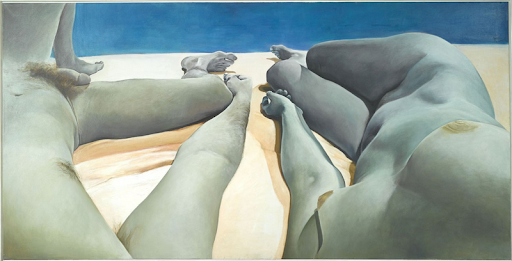ART
A CENTURY OF FEMINIST ART AT THE BROOKLYN MUSEUM
WORDS
by MILENA DEDOVIC
WEB EDIT
by KRISTOPHER FRASER
PHOTOS
COURTESY of BROOKLYN MUSEUM
It isn’t often that an art exhibition feels like a rebellion, but Half the Picture: A Feminist Look at the Collection sends the message loud and clear. The artworks of more than 50 artists are a vigorous testimony of the past century. From the World War I to the #MeToo movement — an initiative against sexual harassment that has spread virally in 2017 — this exhibition brings together many different ways that artists responded to the sociopolitical issues and used their art as a medium to fight sexism and racism within the art world. Loud, fierce, and proud, featured artworks allude to various communities, beliefs and hopes for race, gender and class equality.
It was a long battle for women’s rights before Guerrilla Girls, an anonymous group of feminist, female artists came along with their Reinventing the ‘F’ word: feminism motto. They began the battle for the women’s rights in the 80s by using culture jamming in the forms of posters, billboards, books and appearances as a medium to loudly express themselves. Their approach to art struck me with all the vibrant, socially engaged pieces on the walls. The inspiration behind this exhibition comes from a 1989 Guerrilla Girls poster “You’re seeing less than half the picture without the vision of women artists and artists of color”.

Wendy Red Star (Apsáalooke (Crow), born 1981). Alaxchiiaahush / Many War Achievements / Plenty Coups, 2014, from the series 1880 Crow Peace Delegation. Pigment print on paper, from digitally reproduce
The exhibition is an intriguing mixture of paintings, photographs, sculptures, videos and installations, and is a real treat for the senses. Just take a look at, Betty Tompkins’ Fuck Painting #6, which marks the first time an American museum has featured a work from this controversial series. Tompkins’ painting of the heterosexual intercourse, made between 1969 and 1974, broadened the repertoire of the feminist imagery. In an era of feminists gathering and working collectively, Tompkins decided to create something on her own and address the taboo themes.
The exhibition also features artists like Mickalene Thomas and Ghada Amer, who were portraying their models emphasizing self-possession and pleasure with the goal to challenge the long tradition of white male painters depicting nude women models as passive. Some of the artworks are directly pointing out the contradictions of “liberty and justice for all” - principles of the American nation. Andy Warhol’s screenprint of police brutality against peaceful protesters during the Civil Rights Movement indicates the footprint of the violence on the country without beating around the bush. Another part of the exhibit, Judi Chicago’s The Dinner Party installation, honors the achievements of 1038 historical and mythical women and is a remembrance of all women whose stories were lost to suppression.

Mickalene Thomas (born Camden, New Jersey, 1971) Madame Mama Bush in Black and White, 2007; printed 2011. Chromogenic photograph, 18 ¾ x 23 ½ in. (47.6 x 59.7 cm). Brooklyn Museum; Gift of Mickalene Thomas, 2011.26. ©Mickalene Thomas. (Photo: Jonathan Dorado, Brooklyn Museum)
“It isn’t often that an art exhibition feels like a rebellion, but Half the Picture: A Feminist Look at the Collection sends the message loud and clear.”
Half the Picture: A Feminist Look at the Collection asks provocative questions and brings significant sociopolitical issues and feminist conversations to light. As I was leaving the museum, I spotted the well-known SILENCE = DEATH poster, featuring a pink triangle referring to the AIDS crisis. Originally created by Avram Finkelstein, Brian Howard, Oliver Johnston, Charles Kreloff, Chris Lione and Jorge Socarrás in 1987, it became the central visual symbol of AIDS activism after it was adopted by ACT UP group. The poster is still in the spotlight years later, and remains being an ominous call for action.
The exhibition is on view from August 23, 2018, through to March 31, 2019, at The Brooklyn Museum.

Philip Pearlstein (born Pittsburgh, Pennsylvania, 1924). Portrait of Linda Nochlin and Richard Pommer, 1968. Oil on canvas, 72 x 60 in. (182.0 x 152.4 cm). Brooklyn Museum; Elizabeth A. Sacklet Center for Feminist Art, Gift of the Estate of Linda Nochlin Pommer, TL2018.12. © Philip Pearlstein. (Photo: Jonathan Dorado, Brooklyn Museum)

Betty Tompkins (born Washington, D.C., 1945). Apologia (Artemesia Gentileschi #4), 2018. Acrylic on paper, 11 x 8 ½ in. (27.9 x 21.6 cm). Brooklyn Museum; Elizabeth A. Sackler Center for Feminist Art, Emily Winthrop Miles Fund and Robert A. Levinson Fund, TL2018.10. © Betty Tompkins. (Photo: Jonathan Dorado, Brooklyn Museum)

Vito Acconci (New York City, New York, 1940-2017). Kiss off, 1971. Lithograph and lipstick on paper, 30 1/8 x 22 ¾ in. (76.5 x 57.8 cm). Brooklyn Museum; Gift of Dr. Steven Kazan, 1992. 18.©2018 Vito Acconci / Artists Rights Society (ARS), New York. (Photo: Jonathan Dorado, Brooklyn Museum)

Joan Semmel (born New York City, New York, 1932). Intimacy Autonomy, 1974. Oil on canvas, 50 x 98 in. (127 x 248.9 cm). Brooklyn Musem; anonymous gift, 2004. 117. © Joan Semmel. (Photo: Sarah DeSantis, Brooklyn Museum)

Joan Semmel (born New York City, New York, 1932). Intimacy-Autonomy, 1974. Oil on canvas, 50 x 98 in. (127 x 248.9 cm). Brooklyn Musem; anonymous gift, 2004. 117. © Joan Semmel. (Photo: Sarah DeSantis, Brooklyn Museum)
MORE FROM AS IF

© 2018, AS IF MEDIA GROUP
ALL RIGHTS RESERVED
AS IF MAGAZINE
ABOUT
CONTACT
NEWSLETTER
PRIVACY POLICY
TERMS OF USE
SITE MAP
SUBSCRIPTION
SUBSCRIBE
CUSTOMER SERVICE
SEND A GIFT
SHOP
PRESS CENTER
ADVERTISING
IN THE PRESS
GET IN TOUCH
FOLLOW US
YOUTUBE


.jpg)

